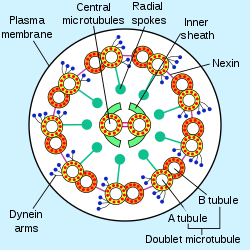Radial spoke
The radial spoke is a multi-unit protein structure found in the axonemes of eukaryotic cilia and flagella.[1] Although experiments have determined the importance of the radial spoke in the proper function of these organelles, its structure and mode of action remain poorly understood.
Cellular location and structure

Radial spokes are T-shaped structures present inside the axoneme. Each spoke consists of a "head" and a "stalk," while each of these sub-structures is itself made up of many protein subunits.[2] In all, the radial spoke is known to contain at least 17 different proteins,[3] with 5 located in the head and at least 12 making up the stalk. The spoke stalk binds to the A-tubule of each microtubule outer doublet, and the spoke head faces in towards the center of the axoneme (see illustration at right).
Function
The radial spoke is known to play a role in the mechanical movement of the flagellum/cilium. For example, mutant organisms lacking properly functioning radial spokes have flagella and cilia that are immotile. Radial spokes also influence the cilium "waveform"; that is, the exact bending pattern the cilium repeats.
How the radial spoke carries out this function is poorly understood. Radial spokes are believed to interact with both the central pair microtubules and the dynein arms, perhaps in a way that maintains the rhythmic activation of the dynein motors. For example, one of the radial spoke subunits, RSP3, is an anchor protein predicted to hold another protein called protein kinase A (PKA). PKA would theoretically then be able to activate/inactivate the adjacent dynein arms via its kinase activity.
However, the identities and functions of the many radial spoke subunits are just beginning to be elucidated.
References
- Karp G (19 October 2009). Cell and Molecular Biology: Concepts and Experiments. John Wiley and Sons. pp. 342–. ISBN 978-0-470-48337-4. Retrieved 25 November 2010.
- Yang P, Diener DR, Yang C, Kohno T, Pazour GJ, Dienes JM, Agrin NS, King SM, Sale WS, Kamiya R, Rosenbaum JL, Witman GB (March 2006). "Radial spoke proteins of Chlamydomonas flagella". Journal of Cell Science. 119 (Pt 6): 1165–74. doi:10.1242/jcs.02811. PMC 1973137. PMID 16507594.
- Yang P, Diener DR, Rosenbaum JL, Sale WS (June 2001). "Localization of calmodulin and dynein light chain LC8 in flagellar radial spokes". The Journal of Cell Biology. 153 (6): 1315–26. doi:10.1083/jcb.153.6.1315. PMC 2192029. PMID 11402073.